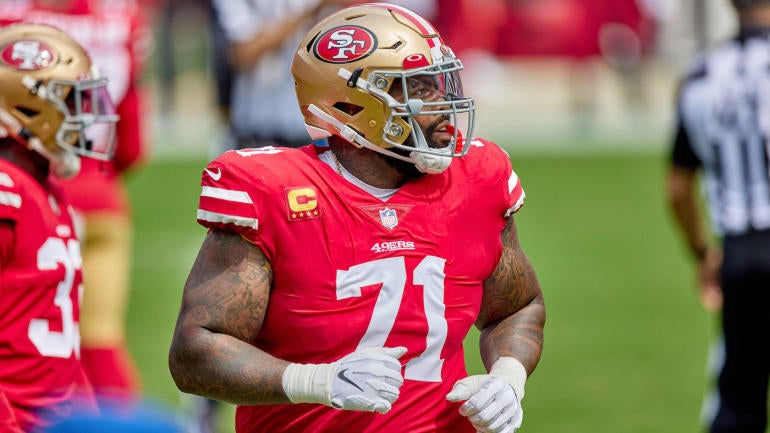
Everything you initially see in a report of a shiny, new NFL contract is wrong. The devil is in the details of every deal. It's perfectly logical that every NFL contract is reported at its absolute maximum length and value -- it doesn't matter who is providing the information to the insider. For agents, it's the best way to show they can secure lucrative contracts for their clients. For teams, it's a PR win that demonstrates they're willing to shell out big bucks for players.
This article is a crash course on how NFL contracts really should be evaluated.
Average annual value
When analyzing a new deal, typically the first thing done is some quick division. Divide the max value by the max length to get the average annual value on a contract. While a very straight-forward, easy-to-sort way of measuring contracts against each other, it needs to stop.
Why, though? Because it's exceptionally rare for a player to play out the entire duration of his non-rookie contract. And because NFL contracts aren't guaranteed like they are in the three other major sports, the usually much smaller amount of guaranteed money is most vital. That figure is how contracts should be compared.
By now, most fans understand that last point. Yet in most cases, AAV based on max length and max value of contracts is used as the barometer by which contracts are compared.
For example, the Bengals signed edge rusher Trey Hendrickson to a four-year, $60 million deal a few days ago. That $15 million in AAV is the 17th-highest among all edge rushers at time of publication. However, his deal features just $16 million guaranteed, which is the 33rd-highest at his position. Really changes the perception of that deal, doesn't it? And it's a perfect segue to...
Total guarantees vs. fully guaranteed at signing
Even if you're firmly aware that guarantees are most important in an NFL contract, there's another layer to them that needs to be understood. Let's get to another example. Left tackle Trent Williams signed a record-setting deal to stay with the 49ers earlier this week. It was presented like this:
Trent Williams exact new contract number on his record-setting six year deal with the 49ers: $138.06 million.
— Adam Schefter (@AdamSchefter) March 17, 2021
It included $55.1 million guaranteed and a $30.1 million signing bonus.
Do the quick math on your phone's calculator and -- bam -- it's a deal with an average annual value of $23.01 million, the highest AAV figure at the offensive tackle position.
Then your eyes to move to the guaranteed figure. And $55.1 million is massive on the guaranteed front.
However, not all guarantees are created equal. While there's been improvement on this front in recent years, in most cases, a new contract for an NFL player is initially reported with total guarantees included in the deal. Those consist of money guaranteed the instant the contract is signed along with guarantees that could be available in the future if that player is on the roster years down the road.
But fully guaranteed at signing is exactly that -- the money a team will be contractually obligated to pay a player regardless of what happens on the field -- at time of signing.
Williams' contract actually only features $40.1 million fully guaranteed at signing -- a $30.1 million signing bonus, his 2021 and 2022 salaries along with $1.25 million of his 2023 salary. Therefore, among offensive tackles, Ronnie Stanley of the Ravens still, by far, was guaranteed the most money of any blocker to sign his name on the dotted line -- $64.1 million -- last year.
A good rule to differentiate these guarantee types in a tweet -- unless you literally read "fully guaranteed" or "fully guaranteed at signing," you can safely assume the total guarantees are being reported to bloat the contract to a perceived higher value.
Here's how the William Jackson deal with the Washington Football Team was presented:
Full terms for the Washington Football Team and new CB Will Jackson III: 3 years, $42M, source said, with $26M guaranteed.
— Ian Rapoport (@RapSheet) March 17, 2021
In actuality, Jackson's deal has $16 million fully guaranteed at signing -- a $15 million signing bonus and his 2021 salary of $1 million. On the third day of the 2022 league year, his 2022 salary of $5 million moves from guaranteed for injury only to a full guarantee. The other $5 million in guarantees comes by way of a 2023 roster bonus if he's on the Football Team at the start of the 2023 league year. And that stipulation brings me to my next point.
Practical guarantees
Those down-the-road provisions in contracts -- when full guarantees for, say, 2023, lock in at the start of the 2022 league year, have created a new term -- practical guarantees. They essentially suggest that a free-agent signing today likely won't be cut after one season, so that kick-in clause is practically a guarantee today. In most cases, practical guarantees are legit.
As the ink is drying on the signature of a new, multi-year deal, no one expects that player to stay with that team for just one season. But in some instances, it does happens. Kyle Van Noy signed a four-year, $51 million deal with the Dolphins a year ago. Van Noy's 2021 salary of $12.5 million would have been fully guaranteed if he was on Miami's roster at the start of the league year. But they cut him. He's now back on the Patriots.
While the Van Noy example is rare, players restructure their multi-year contracts one year into them all the time.
In this free-agent cycle, most contracts have down-the-road provisions that are completely contingent upon the team deciding if it wants that player on the roster in the future. The Chargers signed Corey Linsley to a deal reported as a five-year, $62 million pact with $26 million guaranteed. But all that's guaranteed today is a $4 million salary in 2021 and a $13 million signing bonus. Next March 18, his 2022 salary of $9 million becomes fully guaranteed.
And of course, no one expects Linsley to fall off a cliff in 2021, so his practical guarantee of $26 million is correct. But with how quickly things change in today's NFL, a guarantee in the future is far from concrete today.
Last example -- Packers left tackle David Bakhtiari signed a four-year, $92 million deal last year with Green Bay. His deal featured a $30 million signing bonus. The rest of the total guarantees consisted of roster bonuses at the start of the 2021, 2022, and 2023 league years. If the Packers decide they don't want Bakhtiari's services before the 2022 or 2023 league years begin, those $9.5 million bonuses will not be paid.
Now you have some of the critical context needed to correctly examine NFL contracts, which are certainly not what they originally seem.

















